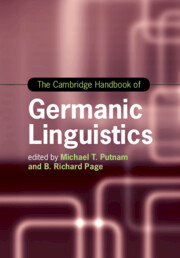Book contents
- The Cambridge Handbook of Germanic Linguistics
- Cambridge Handbooks in Language and Linguistics
- The Cambridge Handbook of Germanic Linguistics
- Copyright page
- Contents
- Figures
- Maps
- Tables
- Contributors
- Acknowledgments
- Germanic Languages
- Part I Phonology
- Part II Morphology and Agreement Systems
- Part III Syntax
- Part IV Semantics and Pragmatics
- Part V Language Contact and Nonstandard Varieties
- Chapter 29 Second Language Acquisition of Germanic Languages
- Chapter 30 Urban Speech Styles of Germanic Languages
- Chapter 31 The West Germanic Dialect Continuum
- Chapter 32 The North Germanic Dialect Continuum
- Chapter 33 Heritage Germanic Languages in North America
- Chapter 34 Minority Germanic Languages
- Chapter 35 Germanic Contact Languages
- Index
- References
Chapter 34 - Minority Germanic Languages
from Part V - Language Contact and Nonstandard Varieties
Published online by Cambridge University Press: 31 March 2020
- The Cambridge Handbook of Germanic Linguistics
- Cambridge Handbooks in Language and Linguistics
- The Cambridge Handbook of Germanic Linguistics
- Copyright page
- Contents
- Figures
- Maps
- Tables
- Contributors
- Acknowledgments
- Germanic Languages
- Part I Phonology
- Part II Morphology and Agreement Systems
- Part III Syntax
- Part IV Semantics and Pragmatics
- Part V Language Contact and Nonstandard Varieties
- Chapter 29 Second Language Acquisition of Germanic Languages
- Chapter 30 Urban Speech Styles of Germanic Languages
- Chapter 31 The West Germanic Dialect Continuum
- Chapter 32 The North Germanic Dialect Continuum
- Chapter 33 Heritage Germanic Languages in North America
- Chapter 34 Minority Germanic Languages
- Chapter 35 Germanic Contact Languages
- Index
- References
Summary
This chapter centers on the sociolinguistic situation of Germanic languages spoken in minority communities around the world. Following a descriptive typology formulated by a geographer (White 1987) and a social psychologist (Edwards 1992, 2004), 21 Germanic minority languages are analyzed with an eye to understanding which external factors promote their maintenance or lead to a shift to a majority language. Special attention is paid to the most successful cases of minority language maintenance, which are found in highly traditional Anabaptist Christian and orthodox Jewish communities. The Germanic heritage languages of these groups are not only surviving, they are growing at rates not matched by any other language, large or small, in the world.
Keywords
- Type
- Chapter
- Information
- The Cambridge Handbook of Germanic Linguistics , pp. 807 - 832Publisher: Cambridge University PressPrint publication year: 2020
References
- 2
- Cited by

